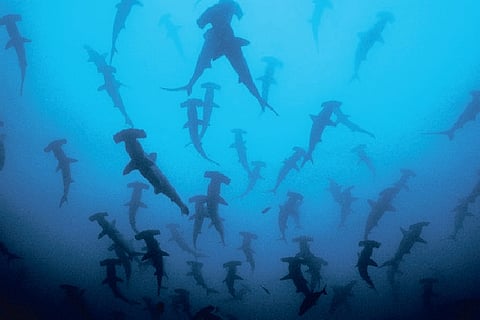

Chennai
Researchers believe they’ve now pinpointed a previously unknown planetary-scale reset that occurred about 19 million years ago.
This extinction event transpired in the world’s oceans and decimated shark populations. The boneless fishes still have not recovered from the damage, the team suggests in a paper published Thursday in Science. Scales cover the bodies — and even the eyeballs — of sharks. Known as “dermal denticles,” these scales function like protective armour and their ridges also reduce drag as the animals swim, said Elizabeth C. Sibert, an oceanographer and palaeontologist at Yale University. These scales are microscopic — each one is only about the width of a human hair — but sharks slough off about 100 denticles for each tooth they lose, making them common in the fossil record. This abundance makes them valuable to scientists seeking to understand the past, said Paul Harnik, a paleobiologist at Colgate University, not involved in the research. “It’s a sheer numbers game.”
In 2015, Dr. Sibert received a box of mud spanning about 40 million years of history. The reddish clay, extracted from two sediment cores that had been drilled deep into the Pacific Ocean seafloor, contained fish teeth, shark denticles and other marine microfossils. Using a microscope and a very fine paintbrush, Dr. Sibert picked through the two sediments and counted the number of fossils in samples separated in time by several hundred thousand years.
About halfway through her data set, Dr. Sibert spotted an abrupt change in the fossil record. Nineteen million years ago, the ratio of shark denticles to fish teeth changed drastically: Samples older than that tended to contain roughly one denticle for every five fish teeth (a ratio of about 20 percent), but more recent samples had ratios closer to 1 percent. That meant that sharks suddenly became much less common, relative to fish, during an era known as the early Miocene, Dr. Sibert concluded.
Dr. Sibert and her collaborators, in an earlier study using the same data set, had also found that sharks declined in abundance by roughly 90 percent about 19 million years ago.
“We had a lot of them, and then we had almost none of them,” she said. “Basically the sharks almost completely disappear.”
These declines in relative and absolute shark abundance suggest that something happened to shark populations about 19 million years ago, Dr. Sibert concluded. But there was still the question of whether a true extinction occurred, she said. “We wanted to know if the sharks went extinct, or if they just became less prominent.” So far, the cause of this die-off remains unknown. There were no climatic changes in the early Miocene, and there’s no evidence of an asteroid impact around that time. “We have no idea,” said Dr. Sibert.
Sharks never fully recovered from this incident, and they have been declining in abundance in recent decades because of overfishing and other human-caused pressures, said Nicholas Dulvy, a marine conservation biologist at Simon Fraser University, not involved in the research.
The writer is a reporter with NYT©2021
The New York Times
Visit news.dtnext.in to explore our interactive epaper!
Download the DT Next app for more exciting features!
Click here for iOS
Click here for Android